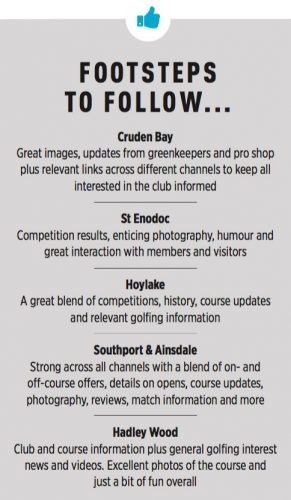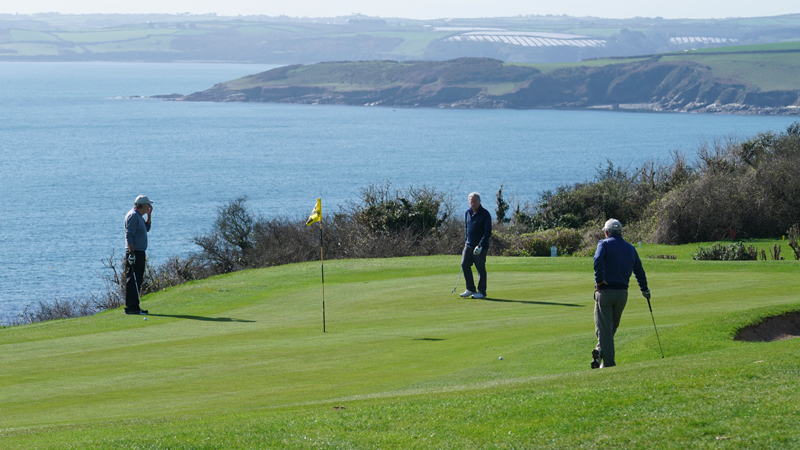Should Your Golf Club Use Social Media?
Many clubs are turning to the likes of Twitter, Facebook and Instagram with the aim of conveying information to members and attracting visitors


Many clubs are turning to the likes of Twitter, Facebook and Instagram with the aim of conveying information to members and attracting visitors
Should Your Golf Club Use Social Media?
Throughout history, the human race has found ways to adapt and innovate to survive and thrive. In a changing social and economic climate, golf clubs would do well to acknowledge this general trait of human existence.
As the requirements and habits of the average golfer change, the majority of golf clubs across this country must change with them to stay viable. Can social media help your club to do this?
Most clubs today view themselves as businesses, and there are few businesses that can afford to ignore the communication channels offered by social media.
Related: UK&I Top 100 courses
A correctly placed and directed post on a social media channel can inform current customers or appeal to new ones. The wider the market a golf club can reach, the more potential customers. It’s fairly simple.
Get the Golf Monthly Newsletter
Subscribe to the Golf Monthly newsletter to stay up to date with all the latest tour news, equipment news, reviews, head-to-heads and buyer’s guides from our team of experienced experts.
Related:
Many golfers, from top professionals to club-level golfers, have a presence on social media – there is a market out there, waiting for your club to reach it.
How to use social media well
Firstly, it’s important to focus on the correct social media avenues. Conduct a survey at the club to find the most-used channels. If 50 per cent of the membership has a Facebook page but only 15 per cent have a Twitter account, Facebook might be the place to start.
Mike Hyde, communications manager at the Golf Club Managers’ Association, regularly advises clubs on social media usage.
“It offers access to key younger demographics that clubs are looking for,” he says. “And the rise of golfers using social media means that even ‘traditional’ golfers are familiar with various platforms.”

But he believes a sound strategy is crucial.
“Clubs should ensure they have the right foundations to build on – a clear, easy-to-navigate website linked to a database that captures the data of visitors and members,” he says.
“Also, social media should be used as part of a wider strategy to deliver a club’s objectives. It’s no use setting up a Twitter account simply because the club down the road has one.”
Consider the sort of content that will do well over social media. The important thing will be to mix up the offering for members and visitors; you don’t want to alienate either group.
For members
Details on club competitions, including entries and results, will be popular, as will updates on the course conditions and upcoming events.
In addition, members can be kept informed of social functions and team events requiring participants. They will also appreciate pictures or videos from the greens staff, as most members are part-time greenkeepers after all! More recent innovations, such as Facebook Live, allow for live interaction between members and club representatives.
All this information adds to the package members receive with their subscription, helping them feel part of things. If used correctly, social media should be fun. Sharing humour, a funny video of a bad shot or a fond memory of a past member draws people in.
Related: What makes a good golf club member?
“It’s an extension of the club environment,” Hyde says. “It might just be the difference between someone renewing or not.”
If seeking new members, social media could be a useful tool to advertise information on open days, reduced joining fees and flexible membership options.
“Facebook, for example, offers an unbelievable advertising opportunity,” Hyde adds.
“Using the simple platform, a club can set up an advert targeting people who have expressed an interest in golf and who live within a certain distance, even down to their postcode. There’s a reason ‘normal’ businesses have been doing this for years!”
For visitors
And what about conveying information to potential visitors? Pictures or videos showing the course in great condition might just capture the attention; a twilight rate or other special deal may be enough to sway an individual or group seeking a venue for a day’s golf.
Largely because of the internet and social media, people are becoming more spontaneous when it comes to planning a round of golf, and having information about conditions and availability at their fingertips will appeal.
Related: How far do average golfers actually hit it?
If someone is organising a last-minute round on a Sunday afternoon and a tweet suddenly comes in saying golf club X is offering a twilight rate, golf clubs Y and Z will likely miss out.
All in the timing
It should be stressed that the posting of offers should be strategic. Flooding social media channels with deals might not be good for business.
If members are constantly bombarded with messages telling them of reduced green fees, or alternative membership options, they may be inclined to reconsider their position. And, if potential new members or visitors see a club with a seemingly constant ‘sale’ on, it might lead them to ask why.
PGA Show 2017: Demo Day Highlights
Who do you trust?
When it comes to frequency and timing, it raises the question of who should have access and who should be permitted and trusted to post?
There are a few examples of a club’s social media account being hijacked, but this is rare.
Staff, committee members and members themselves should be encouraged to engage. Perhaps offer a prize for the most creative or liked post each month.
Related: Do we really need to lengthen our golf courses?
Why ignore it?
“It’s a cliche of digital marketing that people are talking about you, whether you like it or not, and social media is no different,” Hyde says. “Conversations about your club are happening regardless, so it’s best to ensure you harness that feedback – good or bad – to improve your service.”
If used well, social media can be a great tool. Not only can it keep members and frequent visitors informed of developments, conditions and events at the club, but it can also be used to market the course and facilities, creating extra revenue at a time when most clubs need it.
Clubs who ignore social media are missing an opportunity; they must adapt and innovate to survive and thrive.

Fergus is Golf Monthly's resident expert on the history of the game and has written extensively on that subject. He has also worked with Golf Monthly to produce a podcast series. Called 18 Majors: The Golf History Show it offers new and in-depth perspectives on some of the most important moments in golf's long history. You can find all the details about it here.
He is a golf obsessive and 1-handicapper. Growing up in the North East of Scotland, golf runs through his veins and his passion for the sport was bolstered during his time at St Andrews university studying history. He went on to earn a post graduate diploma from the London School of Journalism. Fergus has worked for Golf Monthly since 2004 and has written two books on the game; "Great Golf Debates" together with Jezz Ellwood of Golf Monthly and the history section of "The Ultimate Golf Book" together with Neil Tappin , also of Golf Monthly.
Fergus once shanked a ball from just over Granny Clark's Wynd on the 18th of the Old Course that struck the St Andrews Golf Club and rebounded into the Valley of Sin, from where he saved par. Who says there's no golfing god?
-
 JM Eagle LA Championship Prize Money Payout 2025
JM Eagle LA Championship Prize Money Payout 2025The LPGA Tour heads to California for the JM Eagle LA Championship, where the largest prize money payout of the season so far is on the table
By Mike Hall
-
 Corales Puntacana Championship Prize Money Payout 2025
Corales Puntacana Championship Prize Money Payout 2025The PGA Tour’s latest opposite field event features an attractive prize money payout and some former champions in the field
By Mike Hall
-
 Should Juniors Play In Adult Club Competitions?
Should Juniors Play In Adult Club Competitions?All golf clubs should be working hard to attract and retain junior golfers but is allowing them to play in adult competitions a good way to do it?
By Fergus Bisset
-
 Should Clubs Offer Free Membership For Juniors?
Should Clubs Offer Free Membership For Juniors?Fergus Bisset and Jeremy Ellwood take on each side of the argument.
By Fergus Bisset
-
 10 Things Clubs Can Do To Encourage More Junior Golfers
10 Things Clubs Can Do To Encourage More Junior GolfersJunior golfers are the game's next generation, so it's important that your club is welcoming them in the right way...
By Gary Munro
-
 How PGA Pros Are Nurturing The Next Generation Of Golfers
How PGA Pros Are Nurturing The Next Generation Of GolfersWe speak to two PGA pros to hear how they're getting the next generation engaged with the game...
By Robin Barwick
-
 Why Volunteers Are The Lifeblood Of Golf Clubs
Why Volunteers Are The Lifeblood Of Golf ClubsWithout volunteers, golf clubs would not be able to offer some of their much-loved sessions
By Robin Barwick
-
 How Volunteers Are Helping To Shape The Game Of Golf
How Volunteers Are Helping To Shape The Game Of GolfGolf's grass roots would not be the same without its volunteers...
By Robin Barwick
-
 Are Five-Day Golf Memberships A Good Idea?
Are Five-Day Golf Memberships A Good Idea?Do they offer flexibility or just a discount for the time-rich?
By Fergus Bisset
-
 Why Golf Is Great Through Every Decade
Why Golf Is Great Through Every DecadeFergus Bisset examines why golf remains great through the decades of life and what can be done to enhance the experience further.
By Fergus Bisset